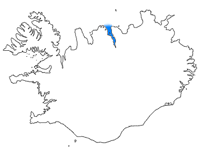Eyjafjörður



Eyjafjörður (Icelandic pronunciation: [ˈeːijaˌfjœrðʏr̥], Island Fjord) is the longest fjord in Iceland. It is located in the central north of the country, near the second-most populous region of Iceland.
Physical geography
The fjord is long and narrow and measures 60 km from mouth to bottom. Its greatest width is 25 km between Siglunes and Gjögurtá at the fjord's mouth but for the greater part of its length it is usually 6–10 km wide. Two smaller fjords branch out of Eyjafjörður's west side, Ólafsfjörður and Héðinsfjörður.
The fjord is surrounded by hills and mountains on both sides but the mountains are considerably taller on the west side, in the mountain range of the Tröllaskagi peninsula. In the outer part of the fjord there are no lowlands along the coast as the steep hills roll directly into the sea. Further south in the fjord there are strips of lowland along both coasts; these are wider on the west side.
Several valleys lead from Eyjafjörður, most of them to the west where the two most significant are: Hörgárdalur and Svarfaðardalur. Dalsmynni is the only valley on the east side. However the greatest valley in Eyjafjörður is also called Eyjafjörður and runs directly south from the fjord itself. It is long and wide and home to one of Iceland's largest agricultural regions.
Many rivers flow into Eyjafjörður, the most significant being Eyjafjarðará, Fnjóská and Hörgá.
The island of Hrísey in the middle of Eyjafjörður is the second largest island of the coast of Iceland and often referred to as "The Pearl of Eyjafjörður".
Eyjafjörður contains a number of hydrothermal vents in shallow (65m-20m) water, with cones rising up to 20m meters below the water surface.[1][2]
People

The region of Eyjafjörður is Iceland's second most populous one after the Capital Region in Southwest Iceland. The total population of the region was approximately 24,000 in 2008 (excluding the town of Siglufjörður and the island of Grímsey that are often associated with Eyjafjörður but do not belong to it in geographical sense.)
The largest town by far is Akureyri, other settlements in the region are: Dalvík, Ólafsfjörður, Hrísey, Árskógssandur, Hauganes, Hjalteyri, Hrafnagil, Svalbarðseyri and Grenivík. Most of these settlements base their livelihood on fisheries and agriculture but Akureyri is a service center as well and the site of a growing university.
See also
References
External links
| Wikimedia Commons has media related to Eyjafjörður. |
Coordinates: 65°51′N 18°08′W / 65.850°N 18.133°W